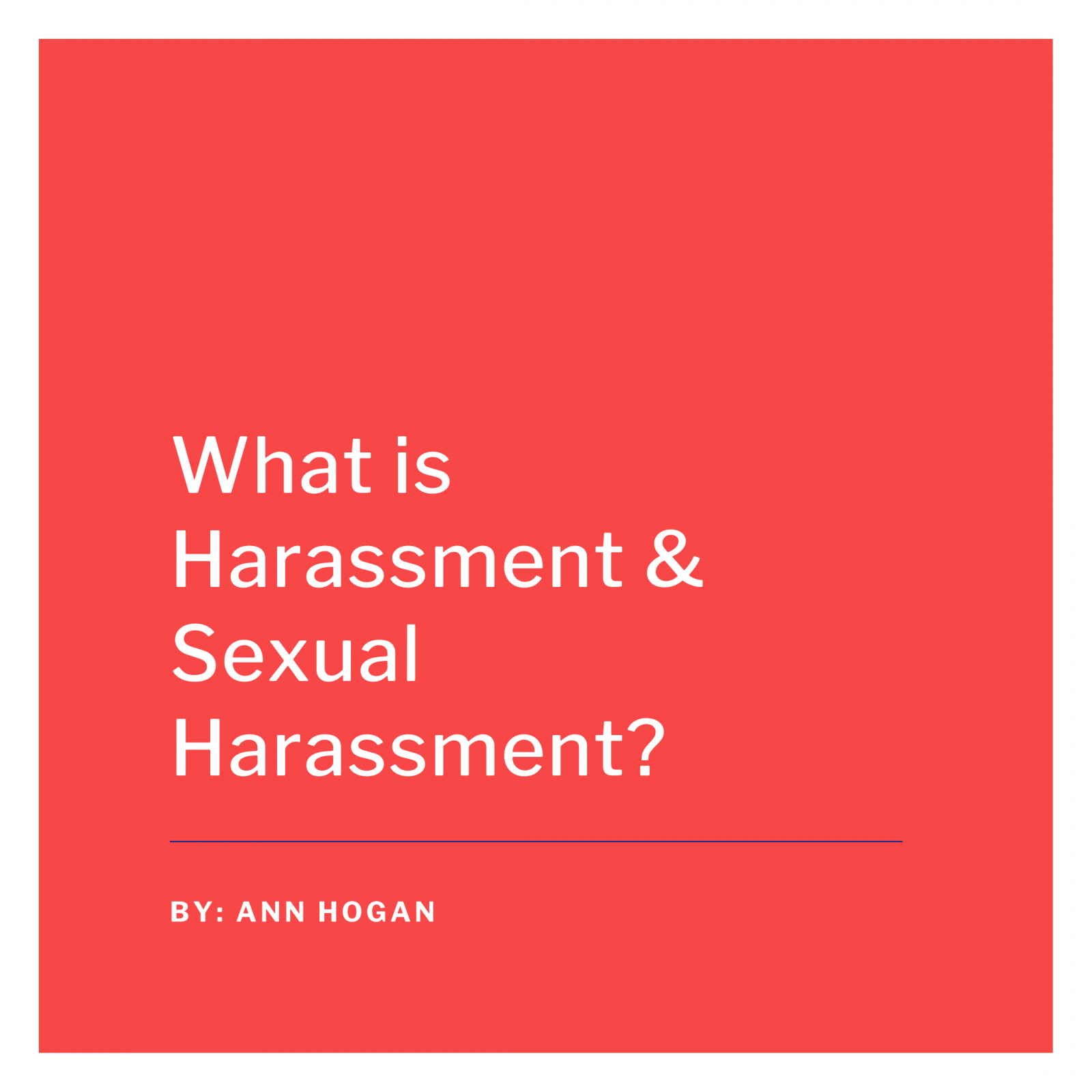What is Harassment and Sexual Harassment?
By: Ann Hogan, M.ED., SPRH, SHRM-SCP
We all want to believe that our organization is a place where all individuals feel safe. This includes employees, clients, patients, vendors and others that visit our workplace. In 2017-2018 Facebook had the hashtag #METOO shared 12 million times…yes, 12 million times!
The 12 million is an important number because it is the number of people (granted a Facebook number) who feel as though they have been harassed or sexually harassed. It is a tough subject to get “real” statistics on as it is something people often don’t report and feel as though they have to “deal” with the behavior that they are being subjected to. ALL forms of harassment are illegal. Employers need to take this seriously as they may be liable for the behavior and in some instances can also be personally liable.
What is Harassment? The EEOC defines harassment as, “unwelcome conduct that is based upon one of these following factors that are covered by Title VII of the Civil Rights Act of 1964, the Age Discrimination in Employment Act of 1967, (ADEA), and the Americans with Disabilities Act of 1990, (ADA):
- Race
- Color
- Religion
- Sex (including pregnancy)
- Age (40 and over)
- National Origin
- Disability
- Genetic information
- Harassment is unwelcome conduct that is based on race, color, religion, sex (including pregnancy), national origin, age (40 or older), disability or genetic information. Harassment becomes unlawful where 1) enduring the offensive conduct becomes a condition of continued employment, or 2) the conduct is severe or pervasive enough to create a work environment that a reasonable person would consider intimidating, hostile, or abusive. Anti-discrimination laws also prohibit harassment against individuals in retaliation for filing a discrimination charge, testifying, or participating in any way in an investigation, proceeding, or lawsuit under these laws; or opposing employment practices that they reasonably believe discriminate against individuals, in violation of these laws.
- Petty slights, annoyances, and isolated incidents (unless extremely serious) will not rise to the level of illegality. To be unlawful, the conduct must create a work environment that would be intimidating, hostile, or offensive to reasonable people.
- Offensive conduct may include, but is not limited to, offensive jokes, slurs, epithets or name calling, physical assaults or threats, intimidation, ridicule or mockery, insults or put-downs, offensive objects or pictures, and interference with work performance.”
What is Sexual Harassment? Sexual Harassment is a form of Harassment under Title VII of the Civil Rights Act of 1964 that falls under Sex Discrimination. The EEOC defines Sexual Harassment as, “Unwelcome sexual advances, requests for sexual favors, and other verbal or physical conduct of a sexual nature constitute sexual harassment when this conduct explicitly or implicitly affects an individual’s employment, unreasonably interferes with an individual’s work performance, or creates an intimidating, hostile, or offensive work environment.
Sexual harassment can occur in a variety of circumstances, including but not limited to the following:
- The victim as well as the harasser may be a woman or a man. The victim does not have to be of the opposite sex.
- The harasser can be the victim’s supervisor, an agent of the employer, a supervisor in another area, a co-worker, or a non-employee.
- The victim does not have to be the person harassed but could be anyone affected by the offensive conduct.
- Unlawful sexual harassment may occur without economic injury to or discharge of the victim.
- The harasser’s conduct must be unwelcome.”
When an employee informs you that they believe they are being harassed, sexually harassed or are working in a hostile workplace it is important to take the claim seriously and do an investigation immediately.
Further information from the EEOC can be found on their website: www.EEOC.gov
It is also important that as an employer, you ask them if any of the behavior they are experiencing is based upon the factors above to see if it meets the definition of harassment. It may be that they are working in a workspace that has no respect or is dysfunctional but doesn’t rise to the level of harassment or hostile work environment, but it is still an unacceptable environment for your organization.
Please beware that your state or local laws may have a broader definition and that definition will take precedence. You may find your individual state and local laws by looking up your States Department of Labor or your local municipality labor laws. If you believe you may have a situation that rises to the level or harassment or sexual harassment you will want to consult with an employment attorney as you move forward.
It is very important that organizations take steps to prevent or eliminate this behavior in the workplace. As a Health Center. it is important that you implement the following:
- Make sure you have a written Harassment Policy and should include, at a minimum:
- Identify what is Harassment
- How to report Harassment
- Responsibility of Reporting Harassment
- No Retaliation for Reporting
- Confidentiality of Reporting (this does mean complete confidentiality, but on a need to know basis)
- Alternative Reporting Structure (in case you need to report the person you are supposed to report the claim to, i.e. HR, CEO, Supervisor etc.…)
- Additionally, make sure all your Vendors and Patients also know Harassment is not tolerated and how to report
- Investigation
- Train all staff and contractors that work for your organization on your Harassment Policy, yearly at a minimum. Training should always be documented and is best done in person, but some states also allow online and/or webinars. Some states have requirements of how the training can be conducted and who can conduct it. For instance, in California the rules are:
- “Attorneys who have been members of the bar of any state for at least two years and whose practice includes employment law under the Fair Employment and Housing Act or Title VII of the federal Civil Rights Act of 1964;
- Human resource professionals or harassment prevention consultants with at least two years of practical experience in:
-
-
- Designing or conducting training on discrimination, retaliation, and sexual harassment prevention;
- Responding to sexual harassment or other discrimination complaints;
- Investigating sexual harassment complaints; or
- Advising employers or employees about discrimination, retaliation, and sexual harassment prevention.
- Law school, college, or university instructors with a post-graduate degree or California teaching credential and either 20 hours of instruction about employment law under the FEHA or Title VII.”
-
Harassment and Sexual Harassment in the workplace is very serious and organizations need to take it seriously. We can not afford to have an attitude that this behavior happens other places but not within our walls. Be proactive and make sure your policy includes the items listed above, that you have mandatory training for all staff and contractors, and that you investigate all claims immediately. This will be your best offense when these situations occur.

Ann Hogan is an employee retention and recruitment expert, HR Consultant, trainer and speaker. She has a master’s degree with a focus on Organizational Performance and Change and is a graduate of the University of Washington Community Health Leadership Institute Certificate Program. She works with organizations to improve retention, customer and employee satisfaction, and communication. Ann can be reached at 303.916.6439 or ann@annhoganconsulting.com





